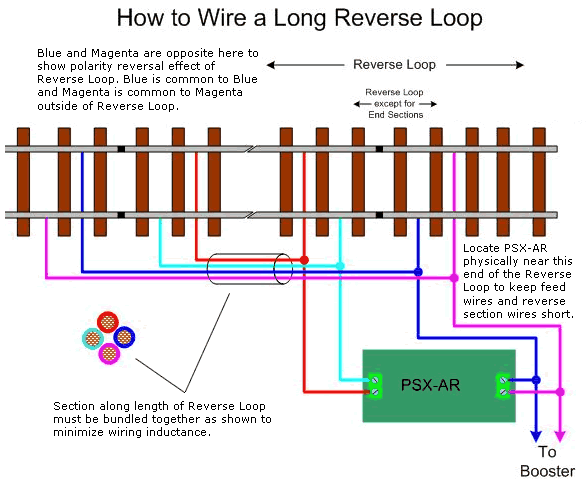How to Wire A Long Reverse Loop
When you have two wires close together in parallel, the magnetic fields due to current flow in each wire couple into the other wire. If you make those currents equal and opposite (such as a main DCC bus), then the magnetic fields will cancel. Since inductance is caused by energy stored in the magnetic field of a wire, if you have the magnetic fields cancel, you have also cancelled the inductance. While this is true for any length of wire, for practical purposes with DCC, you don't need to worry for wire runs under 2-4 feet since the inherent inductance is small to begin with. For longer wire runs, you want to adhere to the basic principle that the wires are close together and the currents in the adjacent wires are equal and opposite.

If you look at the Long Reverse Loop article, you will see that this is the principle that we followed. The PSX and PSX-AR are at one end of the loop, and the PSX feeds the "normal" track at BOTH ends of the loop. Thus, a short at either end of the loop will result in equal but opposite currents in two wires within the cable bundle. However, you want to run a bus from the PSX to the FAR end "normal" track. The reverse loop bus and the far end bus can be held together with zip ties. Every 4 to 6 inches would be good - again you want them close together. Any open loop area is inductance. On the far end of the loop, you want the "normal" track equal to your longest engine before it is fed from another source, and it should be insulated from the next source so that only the PSX paired with the PSX-AR can feed it current. Remember, we are trying to control where the PSX-AR reverse short current flows so that we can work on cancelling the inductance.
The reason we wrote the article is that we had a club layout where the PSX-AR would not work. After a bit of troubleshooting, it turned out that the short circuit path for the PSX-AR reverse current actually was through a single wire circuit that routed almost all the way around the layout. The inductance was so bad, that the DCC waveform had a rise time longer than the data bit time, so the PSX-AR never saw a short circuit current. After rewiring the PSX-AR per the article, the reverse section worked correctly.
